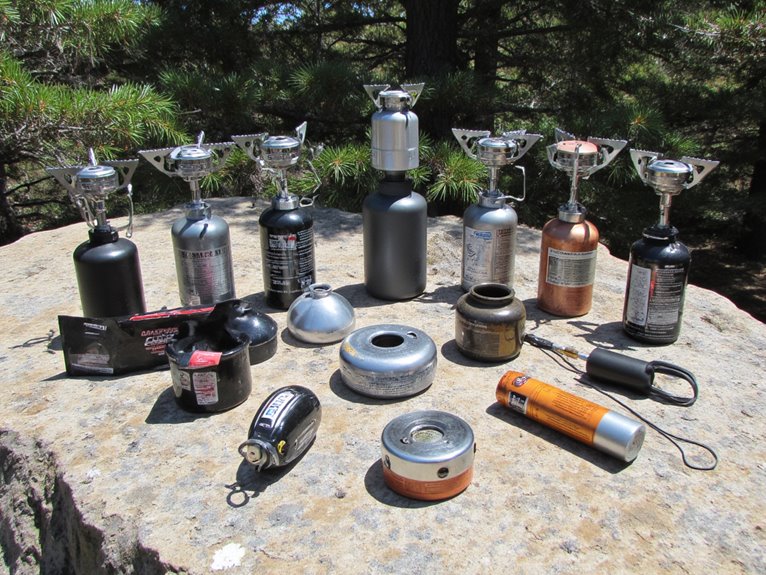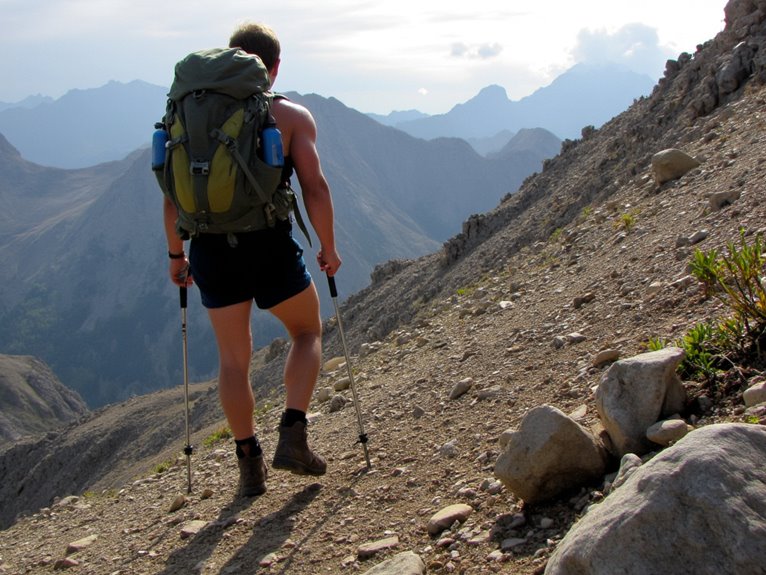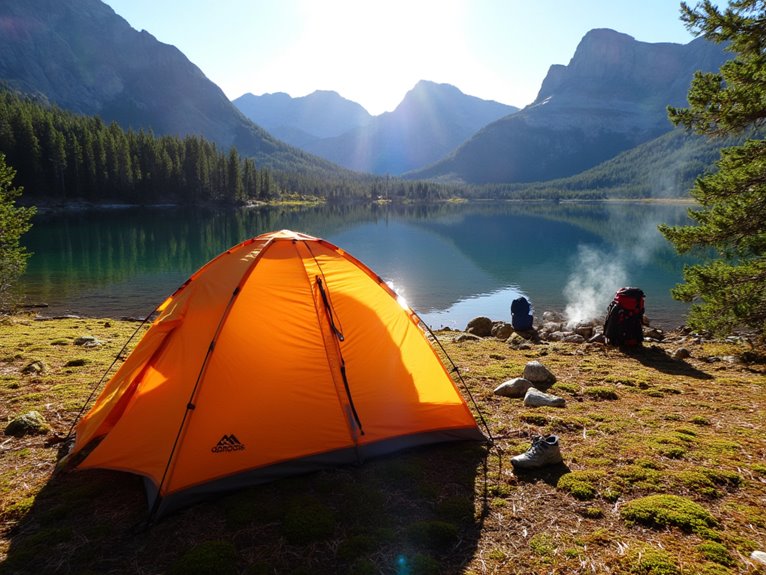How to Choose Large Backpacks for Wilderness Expeditions
You’ll need at least 60 liters for multi-day wilderness expeditions, with 75-110 liters required for mountainous terrain and extended trips. Choose internal frame packs for technical terrain stability, ensuring proper torso length compatibility for effective load transfer. Position heavy items close to your back, with 80-90% of weight distributed through the padded hip belt. Select waterproof materials with reinforced stitching and rain covers weighing 0.2-0.3 pounds. Multiple compartments and external attachment points enhance organization for prolonged backcountry travel where advanced selection strategies become essential.
We are supported by our audience. When you purchase through links on our site, we may earn an affiliate commission, at no extra cost for you. Learn more. Last update on 6th January 2026 / Images from Amazon Product Advertising API.
Notable Insights
- Choose 75-110 liter capacity packs for extended wilderness expeditions to accommodate gear for multi-day trips.
- Select internal frame packs with adjustable torso lengths for better weight distribution and stability on technical terrain.
- Ensure 80-90% of pack weight transfers through padded hip belt for optimal load distribution and comfort.
- Look for waterproof materials, reinforced stitching, and quality rain covers weighing 0.2-0.3 pounds for weather protection.
- Prioritize multiple compartments, side zippers, and external attachment points for efficient gear organization and access.
Determining the Right Capacity and Size for Multi-Day Treks
When selecting a backpack for multi-day wilderness expeditions, capacity requirements directly correlate with trip duration and the volume of essential gear you’ll carry.
For trips lasting four or more days, you’ll need 60 liters minimum to accommodate additional food, water, and equipment. Weekend excursions typically require 40-60 liter packs, balancing storage space with manageable weight.
Proper capacity assessment involves matching your gear volume to pack size while maintaining pack stability. Packs around 50 liters comfortably handle 35-40 pounds when properly fitted to your torso and hips.
A properly fitted 50-liter pack maintains optimal stability while carrying 35-40 pounds of essential wilderness gear.
Loads exceeding 40-45 pounds require larger, more supportive designs for peak stability. Long wilderness expeditions demand 80+ liter capacities to accommodate bulky equipment and extended supply requirements essential for remote conditions.
Extended adventures requiring 50L capacity provide the necessary space for multi-day hiking essentials while maintaining a manageable weight distribution for challenging terrain.
Understanding Frame Types and Support Systems
Your backpack’s frame serves as the structural foundation that determines how efficiently weight transfers from the pack to your body during extended wilderness travel.
Internal frames use lightweight aluminum or composite structures sewn into the back panel, conforming closely to your torso for enhanced pack stability on technical terrain. External frames feature visible metal tubing that excels at distributing heavy loads through robust suspension systems.
Frame compatibility with your torso length is critical for proper load transfer.
Adjustable internal frames accommodate different body sizes, while external frames offer interchangeable components for expedition customization. Aluminum provides durability with moderate weight, while composite materials reduce overall pack weight.
Your frame choice directly impacts how much gear you can comfortably carry and determines your pack’s performance across varied wilderness conditions.
For wilderness expeditions requiring substantial gear storage, consider frames that support large capacity packs like the Loowoko 50L or Maelstrom 40L designs, which offer multiple compartments for efficient organization of essential expedition equipment.
Mastering Weight Distribution and Packing Techniques
Once you’ve selected the right frame system for your expedition pack, proper weight distribution becomes the determining factor between comfortable wilderness travel and debilitating fatigue that can compromise your entire journey.
Effective weight management centers on the hip-spine-shoulder triangle. Position heavy items-water, food, cooking gear-close to your back in the middle layer, maintaining your natural center of gravity.
Load balancing requires 80-90% of pack weight to transfer through your padded hip belt, leaving shoulders to handle only 10-20%.
Layer lightweight bulky items like sleeping bags at the bottom. Place frequently accessed gear-snacks, first aid, rain gear-in top compartments or side pockets.
Tighten compression straps to eliminate load shifting during movement.
Test your fully loaded pack on varied terrain before departure, adjusting strap tension and repositioning items based on pressure points and balance feedback.
Preparing for Challenging Terrain and Physical Demands
Challenging wilderness terrain transforms your backpack from simple storage into a critical piece of survival equipment that must perform under extreme physical stress. Your pack selection requires careful difficulty adjustment based on terrain complexity and expedition duration.
Mountainous environments demand 75-110 liter capacities with robust suspension systems that distribute weight evenly across your torso.
Consider these critical preparation factors:
- Your muscles will scream for relief during steep ascents with 40+ pound loads.
- Weather can turn deadly without quick access to protective layers.
- Equipment failure means potential rescue situations in remote locations.
Match your pack’s capacity to your endurance training level. Internal frame designs with adjustable harnesses maintain load stability on uneven ground.
Position heavy items near your mid-back to optimize balance and reduce fatigue during extended wilderness travel.
Look for backpacks constructed from 900D oxford fabric or similar durable materials that resist tears and scratches when navigating through dense brush and rocky terrain.
Selecting Durable Materials and Weather Protection
When you’re selecting a large backpack for wilderness expeditions, the material’s durability and weather protection capabilities will determine whether your gear survives harsh conditions or fails when you need it most.
Your pack must withstand constant abrasion from rocks and brush while keeping your essential gear dry during unexpected storms or river crossings.
The three critical elements you’ll need to evaluate are waterproof fabric technologies that resist water penetration, reinforced stitching standards that prevent seam failure under heavy loads, and rain cover systems that provide additional protection during prolonged exposure to wet conditions.
Waterproof Fabric Technologies
The fabric that shields your gear from rain, snow, and moisture represents one of the most critical engineering decisions in backpack construction.
Modern waterproof technologies utilize several approaches to protect your equipment while maintaining fabric breathability.
PU-backed polyester provides reliable water resistance at 240-280 gsm weight. PUL fabrics feature TPU film lamination for complete waterproofing.
Waterproof-breathable membranes combine protection with vapor transmission through DWR-treated outer layers.
Consider these performance factors when evaluating waterproof fabrics:
- Membrane efficiency – Porous membranes block liquid while allowing air passage
- DWR coating integrity – Hydrophobic treatments maintain water beading and breathability
- Weight balance – Medium-weight fabrics offer durability without excessive load penalties
Choose rubberized fabrics for extreme conditions despite reduced breathability, or select membrane systems for active expeditions requiring moisture vapor release.
The same principles that make 400T ripstop nylon effective for ultralight sleeping bag shells also apply to backpack durability and weather resistance.
Reinforced Stitching Standards
Beyond waterproof fabric selection, your backpack’s longevity depends on reinforced stitching that withstands expedition stresses.
Critical stress points require specialized stitching techniques like cross-stitching and bar-tack methods at shoulder straps and zipper ends. High-quality packs use marine-grade threads with double or triple stitching layers around load-bearing components.
Durability standards mandate 900D to 1000D+ nylon fabrics paired with heavyweight threads that resist abrasion, moisture, and UV exposure. Manufacturers employ specialized heavy-duty needles to prevent breakage when sewing thick seams.
Weather-resistant thread types resist rot and weakening in variable climates. Structural stitching integrates with suspension systems to distribute heavy loads evenly.
Hip belt and shoulder strap attachments feature reinforced cross-stitch patterns for reliable load transfer. Stitch density matches anticipated pack weight and expedition duration requirements.
Similar to performance underwear construction, backpacks benefit from flatlock seams that reduce friction points and prevent material breakdown during extended outdoor use.
Rain Cover Systems
Rain cover systems protect your expedition gear through three critical materials: polyester, ripstop nylon, and polyester oxford. These tightly woven fabrics effectively block water penetration when enhanced with silicone or polyurethane coatings.
Avoid plain nylon without ripstop weaving due to increased tear risk.
Effective rain cover materials must deliver complete waterproofing:
- Your gear stays bone-dry when PU-coated ripstop nylon repels driving rain and snow
- Your investment survives through sealed seams that prevent catastrophic leaks during storms
- Your expedition continues with abrasion-resistant 40D to 70D fabrics weighing just 0.2-0.3 pounds
Rain cover designs include fitted, semi-fitted, and bag styles. Fitted covers reduce snagging but require precise sizing.
Semi-fitted designs accommodate volume changes while maintaining weather protection through adjustable straps and elastic hems. Quality rain covers incorporate quick-dry materials that facilitate rapid drying after exposure to moisture, ensuring your backpack protection system remains ready for repeated use during multi-day wilderness expeditions.
Essential Features for Extended Wilderness Travel
Seven critical features distinguish expedition-grade backpacks from standard hiking packs when you’re planning extended wilderness travel.
Ergonomic design with adjustable torso length and interchangeable shoulder straps guarantees maximum fit customization. Premium load stability systems distribute 80+ pound loads effectively through reinforced hip belts and load lifter straps.
Weather-resistant materials resist abrasion from rocks and branches during long-term use. Reinforced stitching and heavy-duty zippers withstand harsh expedition conditions better than lightweight alternatives.
Multiple compartment access through side zippers prevents complete unpacking when retrieving gear. Specialized sleeping bag and hydration compartments enhance internal organization.
External attachment points including daisy chains secure bulky items like tripods outside the main compartment.
For multi-day expeditions, internal frame construction provides essential support and weight distribution that external frame packs cannot match in rugged terrain.
These features collectively enable comfortable carrying of substantial gear loads across challenging terrain for extended periods.
Frequently Asked Questions
How Much Should I Expect to Spend on a Quality Expedition Backpack?
You’ll spend $200-$460 for a quality expedition backpack depending on your budget considerations.
Entry-level packs start around $200, while mid-range options cost $300-$400. Premium models exceed $400.
Quality indicators include frame technology, material durability, and load-bearing capacity.
Packs around $300-$400 offer the best balance of performance and specialized features for serious wilderness use without compromising essential expedition requirements.
What’s the Difference Between Men’s and Women’s Specific Backpack Designs?
Gender differences in backpack design center on anatomical fit considerations.
Women’s packs feature shorter torso lengths, narrower shoulder strap angles, and S-curved straps for chest accommodation. Hip belts are wider and more angled to match female hip contours.
Men’s designs typically offer larger capacities with straighter strap configurations. You’ll find women’s packs prioritize breast clearance and narrower shoulder spacing, while men’s focus on broader frames and increased volume capacity.
How Do I Properly Measure My Torso Length for Backpack Fitting?
Proper torso measurement techniques require locating your C7 vertebra at the neck’s base and iliac crest at hip level.
Have someone measure straight down your spine between these points using a flexible tape measure.
You’ll need accurate measurements for perfect backpack fit-typically 15-19 inches for most people.
Stand upright without slouching. This guarantees the pack’s harness aligns correctly with your body for ideal weight distribution.
Can I Use My Expedition Backpack for Airline Travel and Baggage?
You’ll likely need to check your expedition backpack since most exceed airline regulations’ 22-inch length limit.
Large packs typically measure 28-32 inches, making carry-on impossible.
Remove trekking poles, fuel canisters, and sharp objects before checking.
Use a protective duffel cover to prevent strap damage during baggage handling.
Consider travel considerations like transferring essential items to a smaller carry-on bag.
Research your airline’s specific size restrictions and fees beforehand.
How Often Should I Replace My Backpack and What Are Wear Signs?
You should replace your backpack every 5-7 years under regular wilderness use, though backpack durability varies with intensity.
Replacement timing depends on wear signs: frayed straps, torn fabric at stress points, broken zippers, cracked buckles, and compressed padding.
Replace when multiple issues appear simultaneously or repair costs exceed replacement value.
Heavy users and thru-hikers need more frequent replacement due to accelerated wear from high-abrasion activities.
On a final note
You’ve now got the technical knowledge to select a backpack that’ll handle your wilderness demands. Match capacity to trip length-40-60L for weekends, 70L+ for extended expeditions. Choose frame type based on load weight and terrain difficulty. Master weight distribution fundamentals to prevent fatigue and injury. Prioritize durable materials like 210D ripstop nylon and waterproofing ratings above IPX4. Your gear selection directly impacts expedition success and safety.




